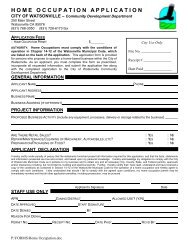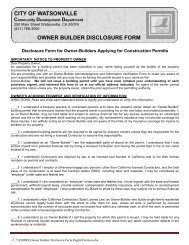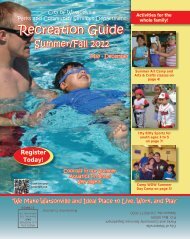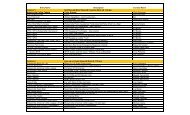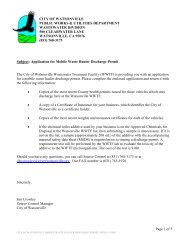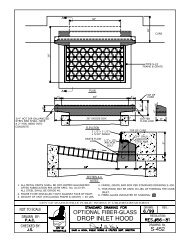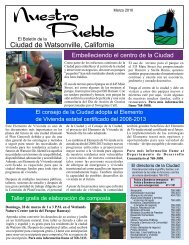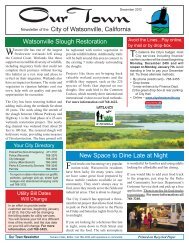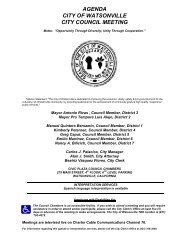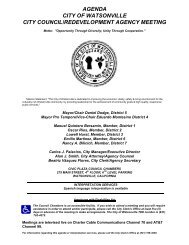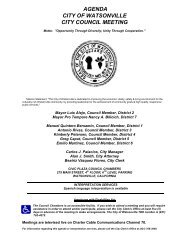Vegetation Management and Maintenance Plan - Watsonville ...
Vegetation Management and Maintenance Plan - Watsonville ...
Vegetation Management and Maintenance Plan - Watsonville ...
You also want an ePaper? Increase the reach of your titles
YUMPU automatically turns print PDFs into web optimized ePapers that Google loves.
4.2.5 Remedial <strong>Plan</strong>ting<br />
The density of plant species in the wetl<strong>and</strong> <strong>and</strong> riparian areas were formulated to allow for<br />
expected mortality rates so that supplemental planting can be kept to a minimum. Even with over<br />
planting, some sites may require supplemental planting, due to unforeseen events or factors, such<br />
as v<strong>and</strong>alism. Remedial planting needs should be assessed during the annual monitoring.<br />
Typically, remedial planting should occur if plant survival rates are less than 80%. The number<br />
of replacement plants, the species, <strong>and</strong> the propagule or container size should be determined by<br />
the monitor <strong>and</strong> stated in the annual monitoring reports. Substitute species may be used, if the<br />
original species consistently performs poorly <strong>and</strong> suitable alternative species perform well.<br />
However, substitute species should be consistent with the goals <strong>and</strong> objectives <strong>and</strong> be compatible<br />
with the criteria for success. The City is responsible for contracting with a native plant nursery (or<br />
similar facility) for the production of the required plants.<br />
Supplemental plant installation should occur in the fall, after the annual site monitoring. This<br />
schedule may be amended, if the necessary plants are not available, are low in quality, or<br />
conditions are deemed unsuitable for replanting. It is desirable to replant as soon as possible to<br />
minimize the extension of the establishment period maintenance.<br />
4.2.6 <strong>Plan</strong>t Installation Techniques<br />
Once replacement plantings are available, they should be installed in the same manner as the<br />
original planting. However, the dead plant material from the original planting must first be<br />
removed. By the time the new plants are ready to install, the dead plant material may have<br />
decomposed. Each reused planting hole should be re-excavated to the specified dimensions <strong>and</strong><br />
prepared to receive the replacement plant. If necessary, a root protector can be installed in the<br />
planting hole. The replacement plant should be carefully removed from its container to avoid any<br />
root damage <strong>and</strong> then should be placed in the planting hole. The planting hole is then back filled<br />
with the original soil <strong>and</strong> a water basin of appropriate dimension constructed. If used, a foliage<br />
protector can be fitted over the replacement plant. The final step is to apply a three-inch layer of<br />
clean mulch.<br />
4.2.7 Restriction of Pesticides in Aquatic Areas<br />
No pesticides (e.g., insecticides, herbicides or rodenticides) are to be used within or immediately<br />
adjacent to aquatic <strong>and</strong> wetl<strong>and</strong> areas. Only chemicals approved by the Environmental Protection<br />
Agency (EPA) for use in aquatic environments may be used within 50 feet of the wetl<strong>and</strong>s.<br />
The application of pesticides shall be directly supervised by a person with a Qualified<br />
Applicators Certificate (QAC) from the State of California Department of Pesticide Regulation.<br />
This person should have sufficient experience in wetl<strong>and</strong>s <strong>and</strong> riparian habitat.<br />
4.2.8 Annual Report Required by CDFG <strong>and</strong> USACE<br />
Under the requirements of the City’s permits with regulatory agencies (i.e., USACE <strong>and</strong> CDFG),<br />
the status of City’s compliance with these permits/agreements should be reported in a yearly<br />
monitoring report (for a period of 5 years after planting). The yearly reports are to be submitted to<br />
the USACE <strong>and</strong> CDFG by December 31 of each monitoring year.<br />
<strong>Vegetation</strong> <strong>Management</strong> <strong>and</strong> <strong>Maintenance</strong> Manual<br />
Draft 42 July 27, 2007




